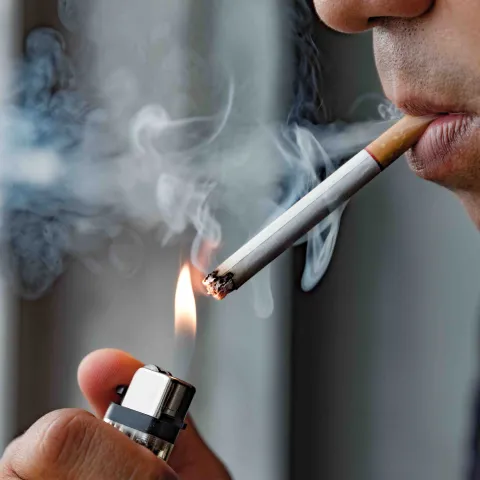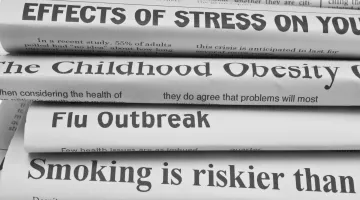Various research projects at the UCLA Center for Health Policy Research examine cigarette, e-cigarette, and marijuana use.
The overall adult smoking rate in California dropped from 16.5% in 2003 to 5.1% in 2023, according to California Health Interview Survey (CHIS) data. However, new products such as e-cigarettes and flavored tobacco products have attracted more teens and young adult users. While smoking can cause direct harm to the smoker — increased risk of cancer, asthma, and emphysema — secondhand smoke is also harmful to nonusers, triggering asthma and other ill effects in adults and weakening lung development in children.
UCLA CHPR researchers not only study smoking practices and health disparities of various populations of Californians, they analyze state and local policies that regulate the use and sale of tobacco and other smoked products, where tobacco and other smoking products can be used, and how they influence smoking behaviors.
Some current and past projects include:

CTCP Priority Populations Initiative Evaluation
The California Department of Public Health’s California Tobacco Prevention Program (CTPP) awarded UCLA CHPR funding through 2025 to conduct the statewide Priority Populations Initiative evaluation, which will assess the overall effectiveness of the Priority Populations Initiative in promoting the adoption and implementation of policy and systems change, community engagement, and partnerships on policy and systems change efforts.
Read the Priority Population Initiative Evaluation fact sheet.
CTCP Health Behaviors and Attitudes on Tobacco (NHPI and LGBTQ)
California’s diverse racial and ethnic groups have different challenges regarding tobacco, e-cigarette, and marijuana use, which require solutions tailored to each population. The California Department of Health’s California Tobacco Control Program (CTCP) funded two California Health Interview Survey (CHIS) follow-on surveys: the California Native Hawaiian and Pacific Islander (NHPI) Tobacco Survey and the California LGBTQ+ Tobacco Survey. Examining two understudied populations, the surveys collected population-disaggregated data on tobacco use, cessation, secondhand exposure, and attitudes regarding tobacco use and control policies among the NHPI and LGBTQ+ populations. CHIS researchers worked closely with subject matter experts and members of the NHPI and LGBTQ+ communities.
In June 2022, UCLA CHPR produced two research reports:
- California Native Hawaiian and Pacific Islander Adult Health Behaviors and Attitudes on Tobacco Use Report
- California LGBTQ+ Health Behaviors and Attitudes on Tobacco Use Report
Read the press release about the studies.
Tobacco-Related Disease Research Program (TRDRP) State and Local Policies on Cigarette Smoking Behaviors and Disparities
The Tobacco-Related Disease Research Program (TRDRP) project examines the interaction of individual and community (neighborhood) factors, and local policies on tobacco use and tobacco-related disparities. The study links existing state-, county-, and city-level tobacco control policies and city-level data on social determinants of health with 2014–2019 California Health Interview Survey (CHIS) data, and then add qualitative data collected through focus groups or interviews to this unique linked data-set to examine the impact of the state and local policies, including local policy characteristics (e.g. types of policies, such as smoke-free housing; comprehensiveness of policies; length of policy adoption; presence of enforcement) on smoking behaviors.

UCLA-Smokefree Air for Everyone (UCLA-S.A.F.E)
UCLA-Smokefree Air for Everyone (UCLA-S.A.F.E.) was a project aimed at reducing exposure to secondhand smoke by increasing access to smoke-free apartments in low-income neighborhoods in the city of Los Angeles.
UCLA-S.A.F.E. was funded by the Centers for Disease Control and Prevention and offered strategic information on smoke-free living. The first set of surveys queried tenants of privately owned multi-unit housing and landlords/owners of multi-unit housing in three Los Angeles council districts about their exposure to secondhand smoke and their attitudes toward smoke-free housing policies.
Read the press release about the UCLA-S.A.F.E tenant/owner surveys.

Smoke-Free Multi-Unit Housing Evaluation
Residents of market-rate, privately owned multi-unit housing — e.g., apartments — are particularly at risk of drifting secondhand smoke. A study by the UCLA Center for Health Policy Research, which interviewed 4,800 tenants of privately owned multi-unit buildings and owners in 12 city council districts in Los Angeles, focused on tenants’ experiences with secondhand smoke in their homes, tenants’ and owners’ views on smoke-free policies, and the potential challenges of enforcing these policies. A majority of tenants and owners supported smoke-free policies toward tobacco and marijuana.
Researchers released a policy brief, Health at Risk: Policies Are Needed to End Cigarette, Marijuana, and E-Cigarette Secondhand Smoke in Multi-Unit Housing in Los Angeles, as well as a series of profiles for 15 council districts in Los Angeles. Read the press release about the Smoke-Free Multi-Unit Housing Evaluation.
Smoking at a Glance
23.4%
of all California adults have smoked 100 or more cigarettes in their lifetime.
Source: 2023 California Health Interview Survey (CHIS)
1 in 20
adolescents ages 15–17 in California are current e-cigarette users.
Source: 2023 California Health Interview Survey (CHIS)
10.5%
of LGBTQ smokers said they delayed or did not seek cessation programs because of perceived unfair treatment due to their sexual orientation or gender identity
Source: California LGBTQ+ Tobacco Survey












